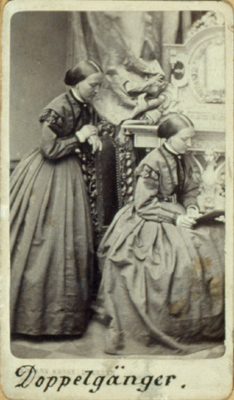As mentioned in my previous post, I am making an effort to start archiving my web interactions that are related to this site.
I recently posted How They Met Themselves, Rossetti’s painting of medieval doppelgangers (I also mentioned this work in Pre-Raphaelites, Doctor Who and how you see the world).
So, with doppelgangers on the brain, I asked on Twitter if anyone could recommend doppelgangers in fiction:
@Tomcat_Redroom tweeted: “There’s a book by Nabokov called ‘Despair’ – it’s about a man who goes mad after meeting his double. And it’s awesome.”
@HorribleSanity: “My favorite dopplegangers are found in 2 short stories, Poe’s “William Wilson” & Alfred Noyes’ “Midnight Express.”
@kathleenoneill: “Wilkie Collins’ ‘The woman in white’ is a great one. And I have to mention the Buffy episode ‘Doppelgangers’, it’s perfect.”
@Robert_Parry who also tweets as TweetsbyWriter and is the author of The Arrow Chest tweeted: “By Schubert/Heine: the full-Gothic Doppleganger hairs on the back of neck standing” and then, he took it a step further and created a blog post about it. The Doppelgangers are spreading!
@HelenaBrors: ” Dostoevsky’s “Dvojnik” and James Hogg’s “The Private Memoirs and Confessions of a Justified Sinner”. ”
@_MelindaBelle: “Frankenstein was one.” and then added “ETA Hoffman wrote one. I don’t know if I have it in the house. But now I want to look. ;>”
Then, @valeriemeachum sent me a link to a book in which she appears as her own Doppelganger. I can’t link to the specific page, but you can flip through. It’s excellent. And I can think of no better setting for a Doppelganger photo than in a beautiful cemetery: Cemetery People
I appreciate all the Doppelganger suggestions, so thank you. After my twitter conversation, my friend Grace (of The Beautiful Necessity) posted this striking doppelganger photo on my Facebook page that she found via Tumblr (R is for Raven). I’ll link the photo to the original Tumblr page:

If you have any more interesting Doppelganger references, let me know. I’m on several different social networks, so feel free to add me or follow me. If you know me through this site, mention it so I can add you back. Be warned: if we have a Pre-Raphaelite related interaction, it will probably make it’s way into a blog post!
Twitter
Google+
Facebook

Hi Stephanie, I have just read on your site: Be warned: if we have a Pre-Raphaelite related interaction, it will probably make it’s way into a blog post! If you like, you could do something with my double story on Jane. I am currently finishing an English text, so you could just copy and paste it, joking. Recent photos of my work are also ready for web presentation. What do you think? Best, Margje.
I blame you for the amount of time I spent this afternoon looking at weird pictures of sisters/twins. Even when it wasn’t specifically a doppleganger of doom, the Victorians loved doubles.
Doctor Who and the Pre-Raphaelites, my 2 passions in one blog. Wonderful, as usual Stephanie. Thank you x
Thank you all for your comments! Margje, I’d love to post something about your doubles story and your photos! And kudos to you for the copy and paste joke 🙂 It’s nice to know someone reads my comments
What’s kudos?! Great, I would love to be posted on your site, could you mail me the specifications for how you would receive my material and how you plan to present it? My address is on my fbpage and on the contact page of my website. And in your mailing list..
http://www.bmagic.org.uk/objects/1956P7
Not sure if this painting qualifies for true doppelgangerdom, but very close…
I’ve always loved that painting. I know it’s probably meant to be charming, but I find it delightfully creepy. Thanks, Olivia, it is unintentionally Dopperganger-ish 🙂
Descending into weirdness:
http://www.darknessembraced.com/paranormal/ghosts-and-hauntings/item/213-doppelgangers-our-mysterious-evil-twin
Woo – Nabokov!
— ‘Despair’ is a great example of an out-and-out doppelgänger in Nabokov, but his books in general are rampant with doubling – from names (Humbert Humbert in ‘Lolita’ or Albert Albinus in ‘Laughter in the Dark’) to strange theories of translation problems and the obstacles implicit in relating literature to the real world (‘Bend Sinister’ has a really beautiful passage about an oak tree being replaced by an iron copy – which is a cool metaphor for the difficulties of both translation and allegory). And we can’t forget Humbert Humbert’s sinister shadow Quilty in ‘Lolita’, who’s always lurking over the horizon and feeds on his paranoia.
His short story ‘Spring in Fialta’ centres around an incestuous group of artistic friends and draws creepy parallels between husband/lover/mistress/wife/artist/critic relationships and the similarities *not* the differences between these positions.
Actually… ‘Laughter in the Dark’ does something similar with a love triangle, in which a precocious young woman strings along a failed ageing academic and a young, charming artist – the academic eventually looses his sight and is, literally, haunted by the younger man in a cruel exploitation of his latent fears of cuckoldry and doubling.
Sorry….
*walks off ranting about Nabokov*…
A great update!!
There’s always Percy Bysshe Shelley’s doppleganger who asked him very mysteriously, “How long do you mean to be content?”
Raine, I was just thinking of Shelley seeing his double before he died. Ever since Stephanie did this, I’ve been on the net looking at dopplegangers, doubled images, and paintings with mirrors.
*neck ache*
*needs two of me*